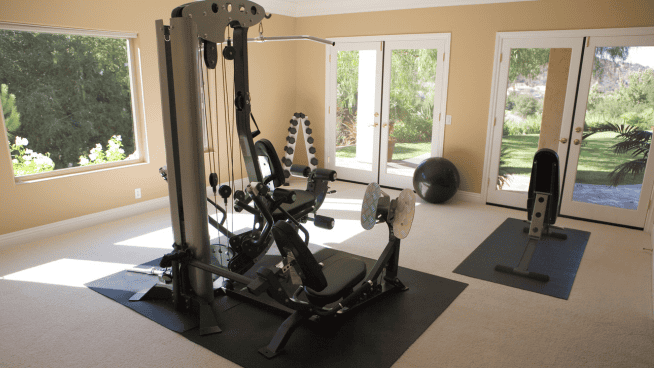The Reverse Plank is the Best Core Exercise You’re Not Doing
You know the Plank. You perform the Plank. You love the Plank. And deservedly because the Plank is a great way to train your core. It’s an anti-extension exercise, meaning your abdominals tighten to prevent your lower back from sagging. This is a much better way to train your core than traditional Crunches. However, if you’re like most athletes, the basic Plank might be feeling a little stale. If so, get ready for a new challenge—the Reverse Plank. Like the Plank, the Reverse Plank requires no equipment and can be performed virtually anywhere. But unlike the basic Plank, the Reverse Plank challenges under-utilized muscles in a totally unique way.
RELATED: The Hardest Plank of All Time
Abs Ain’t Everything
When most people think of their core, they fantasize about a chiseled six-pack—the muscles they can see in the mirror, the muscles society deems most desirable, and the muscles most “core” exercises are designed to target. But the core is much more than the abdominal muscles. It also includes the hip abductors and adductors, hip flexors, lumbar spine, and, according to some training philosophies, even the glutes.
RELATED: 6 Side Plank Variations for a Killer Core
If you want a strong, athletic core that will actually improve your performance and help you play better, you can’t work only on your anterior muscles—i.e., the ones you see in the mirror every day. That’s where the Reverse Plank comes in.
Even if you have strong abdominal muscles, the Reverse Plank will feel challenging the first time you do it. The biggest challenges with the Reverse Plank are to prevent your hips from sagging and to maintain a straight line between your ankle and shoulders. Your abs play a role in this, but most of the work is performed by your lower back, obliques, glutes and hamstrings. These posterior muscles are just as important for athletic performance as your anterior muscles, but they are often under-utilized in core training.
RELATED: Exercise of the Day: Plank to Push-Up
How to Perform the Reverse Plank
The Reverse Plank is a fairly simple exercise with a low risk for injury. The only area of concern is if you have shoulder or wrist mobility problems, but those can be avoided by tweaking your hand position.
- From a sitting position, place your heels on the ground in front of you, and your hands directly under your shoulders.
- Adjust your hand position based on your level of wrist and shoulder mobility. The above photos illustrate three hand positions you can use.
- Bridge up by driving your heels and palms into the ground.
- Drive your hips toward the ceiling until your body forms a straight line from your ankles to your shoulders.
- Activate your core and glutes to hold the position and remain as still as possible.
Your sets and time counts will depend on your ability. Start by performing three sets of 10-second holds. As you progress, work your way up to three sets of 30-second holds.
For an advanced variation of this exercise, try the Reverse Plank with Leg Kicks, seen in this video.
RECOMMENDED FOR YOU
MOST POPULAR
The Reverse Plank is the Best Core Exercise You’re Not Doing
You know the Plank. You perform the Plank. You love the Plank. And deservedly because the Plank is a great way to train your core. It’s an anti-extension exercise, meaning your abdominals tighten to prevent your lower back from sagging. This is a much better way to train your core than traditional Crunches. However, if you’re like most athletes, the basic Plank might be feeling a little stale. If so, get ready for a new challenge—the Reverse Plank. Like the Plank, the Reverse Plank requires no equipment and can be performed virtually anywhere. But unlike the basic Plank, the Reverse Plank challenges under-utilized muscles in a totally unique way.
RELATED: The Hardest Plank of All Time
Abs Ain’t Everything
When most people think of their core, they fantasize about a chiseled six-pack—the muscles they can see in the mirror, the muscles society deems most desirable, and the muscles most “core” exercises are designed to target. But the core is much more than the abdominal muscles. It also includes the hip abductors and adductors, hip flexors, lumbar spine, and, according to some training philosophies, even the glutes.
RELATED: 6 Side Plank Variations for a Killer Core
If you want a strong, athletic core that will actually improve your performance and help you play better, you can’t work only on your anterior muscles—i.e., the ones you see in the mirror every day. That’s where the Reverse Plank comes in.
Even if you have strong abdominal muscles, the Reverse Plank will feel challenging the first time you do it. The biggest challenges with the Reverse Plank are to prevent your hips from sagging and to maintain a straight line between your ankle and shoulders. Your abs play a role in this, but most of the work is performed by your lower back, obliques, glutes and hamstrings. These posterior muscles are just as important for athletic performance as your anterior muscles, but they are often under-utilized in core training.
RELATED: Exercise of the Day: Plank to Push-Up
How to Perform the Reverse Plank
The Reverse Plank is a fairly simple exercise with a low risk for injury. The only area of concern is if you have shoulder or wrist mobility problems, but those can be avoided by tweaking your hand position.
- From a sitting position, place your heels on the ground in front of you, and your hands directly under your shoulders.
- Adjust your hand position based on your level of wrist and shoulder mobility. The above photos illustrate three hand positions you can use.
- Bridge up by driving your heels and palms into the ground.
- Drive your hips toward the ceiling until your body forms a straight line from your ankles to your shoulders.
- Activate your core and glutes to hold the position and remain as still as possible.
Your sets and time counts will depend on your ability. Start by performing three sets of 10-second holds. As you progress, work your way up to three sets of 30-second holds.
For an advanced variation of this exercise, try the Reverse Plank with Leg Kicks, seen in this video.










